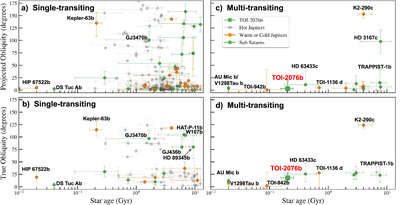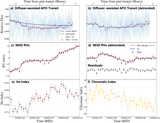Image Details

Caption: Figure 4.
Sky-projected obliquities (a, c) and 3D obliquities (b, d) for planetary systems as a function of age for single-transiting (a, b), and multi-transiting (c, d) systems. Planets with masses >0.3 M J and a/R ⋆ < 10 are classified as hot Jupiters (black points), and as warm Jupiters if a/R ⋆ > 10 (orange points). Planets with masses <0.3 M J are classified as sub-Saturns regardless of the value of a/R ⋆. This classification system is adopted from Albrecht et al. (2022). Despite a lack of a mass measurement of TOI-2076 b we classify it as a sub-Saturn due to its radius and distance. The position of TOI-2076 b is highlighted in red. Obliquity measurements for systems excluding TOI-2076 are drawn from Albrecht et al. (2022), Dai et al. (2023), Bourrier et al. (2023), and the TEPCAT database (Southworth 2011) where the error in the sky-projected obliquity was Δλ < 40°, and the fractional error on the age of the system was less than 90%. W107b denotes WASP-107b.
Copyright and Terms & Conditions
© 2023. The Author(s). Published by the American Astronomical Society.






